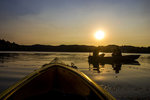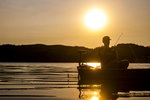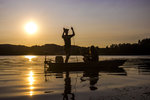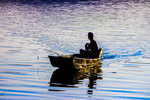



In Western Washington, where marine waters control our climate and permeate our consciousness, salmon and steelhead understandably garner the king’s share of headline ink. But as opportunities for those cherished salmonids continue to dwindle from the days when forebears walked across rivers on their writhing backs, more and more anglers are beginning to spend their time targeting a different species altogether. These days it seems there are just as many anglers looking to rip a lip on a mess of big or smallmouth bass as there are clamoring to sit and watch their poles pulse idly in the river and wait for a spring king or summer steelhead that may never come.
The sport received a boost in July when the Washington Department of Fish and Wildlife promoted what they called “Bass Week”. During that time, WDFW employees made a concerted effort to educate anglers about the wide-ranging opportunities to hook bass all around Washington.
“It’s interesting being a bass biologist in this state because there are a lot of areas where bass and salmon overlap and there can be differences of opinion,” noted Danny Garrett, a warmwater fish biologist out of the WDFW’s Mill Creek office in Vancouver.
During Bass Week, Garrett was busy at the Lake Union shipping canal conducting a predator study on the impact of non-native bass on salmon smolts during outmigration.
“When you look at bass, or perch or other panfish, you usually don’t find smolts in their bellies unless it’s just really good timing,” reported Garrett.
Garrett’s work covers a multitude of species including both large and smallmouth bass, rock bass, yellow perch, bluegill, pumpkinseed sunfish, bullhead catfish, channel catfish, black crappie, and common carp. Of those fish though, the most popular among anglers in Washington are bass.
“Clubs have been around a long time and tournaments have been around a long time in Washington so there’s a real tribe of fishermen who are passionate about bass fishing,” said Garrett, who compared the mentality of bass anglers to tribalism. “Once they switched over to catch-and-release in these bass tournaments, it really opened up because there were so many more places that they could go.”
Garrett noted that bass can be found in most waters and they will bite on a seemingly unending array of baits and lures. That means that no matter where an angler is there are likely bass to be found nearby, it’s just a matter of figuring out exactly where, and what they’ll bite.
“These fish utilize a lot of different habitats. It’s kind of a game when you’re out there and trying to find them. You throw in the fact that they blow up at top water lures and they fight like crazy, it’s just an easy sport to get excited about,” said Garrett. “The popularity is not about how good the fish are to eat, although you can fry them up just like any other fish, but the popularity is about the sport. It’s kind of one of those memories that you just won’t forget.”
One of the tricks to targeting bass is to cast near structures or logjams in the water. Garrett noted that juvenile fish use structures for cover so there tends to be plentiful prey for hungry bass in those areas.
“That’s why cover is good for larger bass because there are a lot of smaller fish for them to eat and it also creates an ambush point,” explained Garrett. “Largemouth bass are very much a lie and wait predator. Smallmouth are a little different. They roam miles at times searching out their food.”
Garrett noted that the preferred diet for bass varies by species. Smallmouth bass tend to forage like trout whereas a largemouth bass will eat everything from perch and crappie to a frog, small duck, or even a bullhead catfish. But neither species is particularly picky.
“There’s nothing you won’t find in a bass’s stomach,” said Garrett.
While live bait is popular in other states, a Washington state ban on minnows limites those opportunities here.
“As far as lures, it’s very dependant upon the time of year because it depends on where the bass are hanging out,” pointed out Garrett. “Any setup I mention will catch either species of fish. It’s dictated more by the conditions you are fishing rather than what their preference is.”
In general though he recommended using a dropshot ring with a finesse worm for smallmouth bass. “A lot of tournaments have been won on that little rig,” noted Garrett.
For largemouth bass, Garrett offered up a variety of techniques. For starters, anglers can use a skirted jig with a trailer that flutters behind to create action.
“The reason a jig looks so good is with that skirted body and that trailer it really looks like a bluegill in the water,” explained Garrett.
He said salt impregnated stick baits also work well.
“It sinks so quickly that when you rig it on a worm, the tail will actually wiggle back and forth,” said Garrett. “It looks like a distressed bait fish that’s about to die.”
Still, he says Senko rubber worms or basic spinners are the best bet for beginning bass anglers.
“You can’t do anything wrong unless you reel it out of the bass’s mouth,” added Garrett.
Figuring out the proper depth to fish at is another variable that will differ by time of day and time of year. Most bass fishing takes place in closed bodies of water like lakes or ponds that are subject to considerable temperature swings. Typically the bass will come up to feed while its cool in the spring or fall, morning or evening, and they tend to go down low to cooler waters midday, especially during the summer. Garrett said that during spawning season between mid-May and mid-June, it’s possible to catch bass right off of their spawning beds down below the thermic line.
“They are very aggressive in defending their nests and will do anything to chase away your lure including biting it,” said Garrett.
The best bass angling is typically in spring and fall, followed by summer, and then winter when colder temperatures slow their metabolism down. Regardless, Garrett says the most dedicated bass anglers keep right on fishing from November through February in certain waters.
“People still catch them throughout the winter in 40-50 feet of water in Lake Washington, Lake Sammamish and Lake Stevens, Riffe Lake, Lake Tapps and American Lake,” said Garrett.
Whereas bass in lakes and ponds are highly sensitive to water temperature fluxuations, river dwelling bass typically see a much more narrow range of water temperatures which means the fish can be more predictable to locate.
“The river bass are cool because now you’re in the trout world again except you’re looking for a different beast,” said Garrett. He recommended casting in deep pools behind large boulders or in deep runs with cobble at the bottom in order to find bass in rivers like the Columbia and Chehalis. Additionally, he said that smallmouth bass tend to stick to the river riffles while largemouth bass like to lurk in the slower backwaters. Garrett says about 90 percent of the bass bite on the Columbia River is made up of smallmouth due to the cooler temperatures.
Aside from the Chehalis River the most popular bass waters in Lewis County include Riffe Lake, Swofford Pond, South Lewis County Park Pond and Old Mill Pond (Carlisle Lake). An annual bass tournament is even hosted each fall at Riffe Lake. This year, that event will take place on Sept. 15. Garrett also recommended trying Silver Lake in Cowlitz County.
By far though, the bulk of the bass fishing in Washington takes place east of the Cascade Mountains.
“I think we have just as many bass anglers in Western Washington, but in terms of destination, absolutely, it’s Eastern Washington,” said Garrett, who listed off Potholes Reservoir, Moses Lake, Banks Lake, Lake Roosevelt, and the middle section of the Columbia River as popular bass waters in the arid lands. “These are destination fisheries that are just phenomenal and people will travel there to go fish. Here in Western Washington, our larger lakes fish very well too, it’s just that you have to compete with more people and more boats.”
Garrett added that next year the Fishing League Worldwide bass circuit will conduct a tournament on the Columbia River at Kennewick. “It’s going to showcase the sport of bass fishing to people who aren't’ familiar with it on an elite scale,” he said.
No matter which side of the Cascades, or even the Rockies you are on, bass are not a native species. Instead they owe their prevalence and continued proliferation to the efforts of various government agencies and bass bootleggers alike.
“All of these species on these warmwater fish are non-native to Washington. There was a very low diversity of species here historically compared to back east. It was pretty much just salmon, steelhead and trout here,” said Garrett as he prepared to deliver a history lesson.
He noted that the Mississippi River runs north to south, so, “During the last ice age, those warmer fish had a way to swim downstream and not get killed off whereas over here in the west, our streams run east and west so the only fish that could survive the last ice age are cold water fish.”
Because bass are native on the East Coast and down in Dixieland, Garrett noted that bass fishing is “very much engrained in the culture in the south like salmon and halibut and lingcod are here in the Pacific Northwest.”
Garrett noted that bass were first brought West on trains by the Department of Commerce in the early 1900s and then spread to billabongs around the state by “bucket biologists” who literally carried the fish in buckets before dumping them into their new waters.
“Bucket biology has really changed the scenery. People would just take a bass and put them anywhere. They still do that in fact. We get very frustrated with people doing that illegally,” Garrett said. “We do it (stock bass) in places that are appropriate. In highly altered waters that are not connected to salmon bearing waters.”
The state record for a largemouth bass is a 12.53 pound fish caught in 2016 out of Lake Bosworth in Western Washington. The state record for smallmouth bass is 8.75 pounds and it has stood since 1966.
“That’s an older record but everyone thinks it's going to be broken eventually,” said Garrett. He noted that the average largemouth bass is about 14-16 inches and between 2 and 2.5 pounds. An average smallmouth bass on the other hand will be about the same length but weigh a little less.
“They’re awfully close until you get into the older fish and then they really separate themselves,” said Garrett.
The daily limit for largemouth bass is five fish. Of those fish, only one may be over 17 inches and the rest must be under a foot long. The daily limit for smallmouth bass is 10 fish and only one may measure more than 14 inches in length.
“These rules were designed from our stock assessment work and they reflect our desire to protect quality fish that do take awhile to get to a larger size,” explained Garrett. However, he noted that two years ago, protections for bass were removed on the Lower Columbia River and its tributaries in order to better align the WDFW’s efforts to preserve salmon-threatened salmon runs.
Even though he believes bass are responsible for only a limited loss of salmon smolts each year, Garrett recognizes that, “You just can’t protect a predator when you are pumping millions into preservation.”
While most anglers elect to toss back their bass catch, the fish are entirely edible. Garrett compared their taste to that of bluegill, black crappie or yellow perch and noted that, much like catfish, a twelve inch bass will taste better than a bigger fish.
“They make great fish and chips,” he claimed.
Some anglers have openly scoffed at the idea that bass need to be promoted and fear that efforts like “Bass Week” represent a white flag for the good old days when salmon and steelhead fishing were strong enough to carry the water for recreational fisheries all on their own.
That conspiracy tinged notion is one that had Garrett quickly on the defensive.
“There is no large or single person with an agenda who is controlling the WDFW. We are a large group, a multifaceted group, with lots of different programs,” said Garrett. “We are about teaching people how to fish and telling them where big opportunities are. One third of anglers are warm water fishers, so to not speak to those people and ignore them just because we are trying to protect salmon does not mesh with our mission as an agency.”
Garrett continued, “Everyone wants salmon but we manage both. We have both and we’re never going to get rid of one for the other. Everybody likes to pick sides but the agency doesn’t pick sides, unless we have to.”